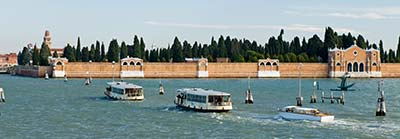When the Piazza San Marco has more tourists than pigeons and the No. 1 vaporetto
is wallowing under the weight of its passengers on the Grand Canal, there's one place in
Venice where the crowds are quiet and unobtrusive: the Isola di San Michele, a former
prison island less than five minutes away by water bus.
San Michele is Venice's cemetery--a role it has borne with dignity since the early
1800s, when Napoleon's occupying forces told the Venetians to start hauling their dead
across the water instead of burying them all over town.
A cruise ship for the departed
In The World of Venice, Jan Morris compares the cemetery
island to a ship where "the director stands as proudly in his great graveyard as any
masterful cruiser captain, god-like on his bridge."
"The church at the corner of the island is beautifully cool, austere and
pallid, and is tended by soft-footed Franciscans ... The cemetery itself is wide and calm,
a series of huge gardens, studded with cypress trees and awful monuments.
"Not long ago it consisted of two separate islands, San Michele and San
Cristoforo, but now they have been artificially joined, and the whole area is cluttered
with hundreds of thousands of tombs--some lavishly monumental, with domes and sculputures
and wrought-iron gates, some stacked in high modern terraces, some stacked in high modern
terraces, like filing systems."
 The word "cluttered" seems a bit unfair. The Catholic areas of San Michele
are laid out with far greater precision and formality than you'd find in the typical
American or British cemetery.
The word "cluttered" seems a bit unfair. The Catholic areas of San Michele
are laid out with far greater precision and formality than you'd find in the typical
American or British cemetery.
Walls separate the various areas, and the graves lie in neat
(if tightly packed) rows that are separated by walking paths for the convenience of
mourners and visitors.
Here and there, the path leads to a border of contiguous
marble-topped crypts that must be traversed to leave the garden. ("Is it okay to walk
on the tombs, honey?" "I dunno. But we're wearing our rubber-soled shoes, so
maybe the caretaker won't notice.")
Segregation by sect

ABOVE: Vaporetti run to the island
almost constantly during All Saints' Week.
 Most of San Michele's acreage is reserved for Catholics--a fact that's hardly
surprising in a country where Roman Catholics, practicing or otherwise, make up the vast
majority of the population.
Most of San Michele's acreage is reserved for Catholics--a fact that's hardly
surprising in a country where Roman Catholics, practicing or otherwise, make up the vast
majority of the population.
In
Venice: The Art of Living, Frédéric Viteaux describes the
Catholic cemetery during All Saints' Week:
"A free vaporetto takes the inhabitants of the city from the Fondamenta Nuove
to the island. The women carry flowers--their figures swallowed up by pots of huge
chrsyanthemums, rumpled and white, yellow, and pink.
"They look like an army of flowers on
the march disembarking in front of the church and the Emiliani chapel, filing into the
right-angle lanes of the cemetery. The chrysanthemums advance like the forest in Macbeth.
"The living have done their duty. They return to the vaporetto, satisfied. Perhaps the dead
are, too."
The island has two mini-graveyards for other Christian sects: the Greci or
Greek Orthodox cemetery, where Igor Stravisky and Sergei Diaghilev are buried; and the
Protestant graveyard, whose most famous resident is Ezra Pound.
(Jews have their own
cemetery on the Lido, Venice's resort island.)
 In contrast to the formal and beautifully tended Catholic gardens of graves, the Greci
and Protestant sections have an atmosphere of rustic decay.
In contrast to the formal and beautifully tended Catholic gardens of graves, the Greci
and Protestant sections have an atmosphere of rustic decay.
Some tombstones are covered in
moss; a few lean at precipitous angles; several have keeled over in a parody of those
whose deaths they commemorate.
The occasional English epitaph reminds visitors of a time
when the British upper classes regarded Venice as a home away from home.
The most famous
inscription honors a Staffordshire man who was said to have "Left us in peace, Febry
2, 1910."
"Your checkout time is 2029"

ABOVE: Mausoleums at the San Michele island
cemetery. INSET BELOW: Venetians visit family members' graves during All Saints'
Week.
Death may be permanent, but San Michele is so crowded
that graves are on short-term lease.
 The bodies in each row of graves are allowed to decompose for twelve years, at which
point they're dug up.
The bodies in each row of graves are allowed to decompose for twelve years, at which
point they're dug up.
Occupants whose families can pay for reinterment are transferred to
small metal boxes for permanent storage in smaller quarters. The less well-heeled get
tossed into a nearby boneyard.
In the old days, bones were dumped on the ossuary island of Sant'Ariano, which Michael
Dibdin describes in his novel Dead Lagoon:
"...The surface inside was much higher, almost level with the top of the wall.
Giacomo stepped down and started to push his way through the undergrowth, following a
series of almost imperceptible markers: the torn ligaments of a branch dangling from a
bush, a patch of flattened grass, the sucker of a bramble bush, thick as a squid's
tentacle, lopped off clean by a fisherman's gutting-knife.
"The ground crunched and
slithered underfoot, as though he were walking on layers of broken crockery.
"A sudden scuttling noise brought him to a halt, wielding his torch-beam like
a staff. The island was infested with snakes, and Giacomo tried with limited success to
convince himself that this was the only feature of the place that scared him."
How to reach San Michele
If you're dead, the undertaker will deliver you to the cemetery
by aquatic hearse (or by funeral gondola if your survivors have a flair for the dramatic).
 For a more temporary visit, catch the No. 41 or 42 vaporetto at the Fondamenta Nuove
platform.
For a more temporary visit, catch the No. 41 or 42 vaporetto at the Fondamenta Nuove
platform.
Get off the boat at the first stop, "Cimitero."
After you've visited San Michele, you might want to continue on to
Murano, the glass island, via the same waterbus
line.
Book suggestion:
Permanent
Italians, a trade paperback by Judi Culbertson and Tom Randall, has a
chapter on the late and the great who are buried or entombed in Venice.
About the author:
 Durant Imboden has
written about Venice, Italy since 1996.
He covered Venice and European travel at About.com for 4-1/2 years before launching
Europe for Visitors (including
Venice for Visitors) with Cheryl
Imboden in 2001.
Durant Imboden has
written about Venice, Italy since 1996.
He covered Venice and European travel at About.com for 4-1/2 years before launching
Europe for Visitors (including
Venice for Visitors) with Cheryl
Imboden in 2001.
PC Magazine has called this "the premier visitors'
site for Venice, Italy." Over the years, it has helped more than 30 million
travelers. For more information, see About our site,
our Europe for Visitors
press clippings,
and
our reader testimonials.